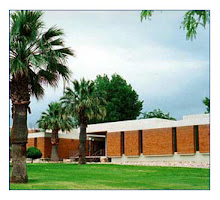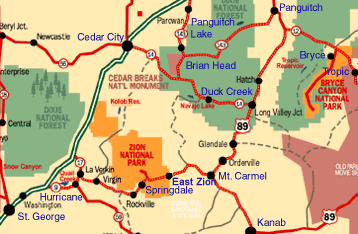
The Bonneville Salt Flats is located near the Utah-Nevada border, along I-80. It is one of the many unique natural features in Utah. It covers an area of more than 30,000 acres and it is administered by the Bureau of Land Management.
During the last Ice Age, about 15,000 years ago, Lake Bonneville was about the size of Lake Michigan. It covered one-third of present day Utah and parts of surrounding states. You can see traces of the shorelines, representing different levels of the receding lake, etched into the mountains surrounding the salt flats.
The Bonneville Salt Flats and the Great Salt Lake are what remains of ancient Lake Bonneville. Wind and water each combine to create the flat surface of salt. Every winter, a shallow layer of standing water floods the surface of the salt flats. Then during spring and summer, the water slowly evaporates while winds smooth the surface into a vast, nearly perfect flat plain.
The salt surface contains potassium, magnesium lithium and sodium chloride (which is common table salt).
Around 1824, Jim Bridger and other mountain men explored the Great Salt Lake desert region. The first recorded crossing of the desert was made in 1845 by Captain John C. Fremont's survey party, with scouts Kit Carson and Joe Walker. Early the next year, 23 year old Lansford Hastings retraced Fremont's trail across the salt plain. Joe Walker's writings warned emigrants not to attempt the untried route; however, Hastings convinced several emigrant parties to follow him.
Despite Walker's warnings, the Donner-Reed party, seeking a shortcut to California in 1846, attempted the "Hastings Cutoff". They failed to take enough water and lost a critical number of oxen. Four of their wagons were abandoned just 10 miles northeast of the salt flats. Time was lost, and the delay resulted in their late arrival to the Sierra Nevada Mountains and their tragic winter.
Later, in 1910, the first permanent crossing of the Bonneville Salt Flats was completed when the Southern Pacific Railroad was built linking Salt Lake City and San Francisco.
The Bonneville Salt Flats is named in honor of Captain B.L.E. Bonneville, whose expeditions in the 1830's proved the area was part of an ancient basin.
Try to imagine a place so flat you seem to see the curvature of the planet, so barren not even the simplest life forms can exist. Imagine the passing thunder of strange vehicles hurtling by on a vast dazzling white plain. This is not an alien world far from earth; it is Utah's famous Bonneville Salt Flats.
Thousands of visitors, commercial filmmakers, and of course, high speed auto racers, make the Bonneville Salt Flats a world famous destination. By way of information….one scene in the third film of the “Pirates of the Caribbean” series was filmed on the Salt Flats (the scene was when the pirate ship Pearl was on this great white unending plain).
The salt flats' potential for racing was first recognized in 1896 by W.D. Rishel who was scouting a bicycle race course from New York to San Francisco. Rishel returned and convinced daredevil Teddy Tezlaff to attempt an automobile speed record on the flats. Tezlaff drove a Blitzen Benz 141.73 m.p.h. to set an unofficial record in 1914.
The salt flats drew international attention in the 1930's when Utah driver Ab Jenkins lured British racer Sir Malcolm Campbell to compete for speed records on the salt surface.
By 1949, the raceway on the Bonneville Salt Flats was the standard course for world land speed records. On this natural straightaway the 300, 400, 500, and 600 mile per hour land speed barriers were broken.
Since the first speed record attempts in 1914, hundreds of records have been set and broken in a variety of automotive and motorcycle classes.
Typically, speed trials are scheduled throughout the summer and fall at the Bonneville Raceway. Most events are open to the public. The annual Speed Week is usually held in mid-August.
During the last Ice Age, about 15,000 years ago, Lake Bonneville was about the size of Lake Michigan. It covered one-third of present day Utah and parts of surrounding states. You can see traces of the shorelines, representing different levels of the receding lake, etched into the mountains surrounding the salt flats.
The Bonneville Salt Flats and the Great Salt Lake are what remains of ancient Lake Bonneville. Wind and water each combine to create the flat surface of salt. Every winter, a shallow layer of standing water floods the surface of the salt flats. Then during spring and summer, the water slowly evaporates while winds smooth the surface into a vast, nearly perfect flat plain.
The salt surface contains potassium, magnesium lithium and sodium chloride (which is common table salt).
Around 1824, Jim Bridger and other mountain men explored the Great Salt Lake desert region. The first recorded crossing of the desert was made in 1845 by Captain John C. Fremont's survey party, with scouts Kit Carson and Joe Walker. Early the next year, 23 year old Lansford Hastings retraced Fremont's trail across the salt plain. Joe Walker's writings warned emigrants not to attempt the untried route; however, Hastings convinced several emigrant parties to follow him.
Despite Walker's warnings, the Donner-Reed party, seeking a shortcut to California in 1846, attempted the "Hastings Cutoff". They failed to take enough water and lost a critical number of oxen. Four of their wagons were abandoned just 10 miles northeast of the salt flats. Time was lost, and the delay resulted in their late arrival to the Sierra Nevada Mountains and their tragic winter.
Later, in 1910, the first permanent crossing of the Bonneville Salt Flats was completed when the Southern Pacific Railroad was built linking Salt Lake City and San Francisco.
The Bonneville Salt Flats is named in honor of Captain B.L.E. Bonneville, whose expeditions in the 1830's proved the area was part of an ancient basin.
Try to imagine a place so flat you seem to see the curvature of the planet, so barren not even the simplest life forms can exist. Imagine the passing thunder of strange vehicles hurtling by on a vast dazzling white plain. This is not an alien world far from earth; it is Utah's famous Bonneville Salt Flats.
Thousands of visitors, commercial filmmakers, and of course, high speed auto racers, make the Bonneville Salt Flats a world famous destination. By way of information….one scene in the third film of the “Pirates of the Caribbean” series was filmed on the Salt Flats (the scene was when the pirate ship Pearl was on this great white unending plain).
The salt flats' potential for racing was first recognized in 1896 by W.D. Rishel who was scouting a bicycle race course from New York to San Francisco. Rishel returned and convinced daredevil Teddy Tezlaff to attempt an automobile speed record on the flats. Tezlaff drove a Blitzen Benz 141.73 m.p.h. to set an unofficial record in 1914.
The salt flats drew international attention in the 1930's when Utah driver Ab Jenkins lured British racer Sir Malcolm Campbell to compete for speed records on the salt surface.
By 1949, the raceway on the Bonneville Salt Flats was the standard course for world land speed records. On this natural straightaway the 300, 400, 500, and 600 mile per hour land speed barriers were broken.
Since the first speed record attempts in 1914, hundreds of records have been set and broken in a variety of automotive and motorcycle classes.
Typically, speed trials are scheduled throughout the summer and fall at the Bonneville Raceway. Most events are open to the public. The annual Speed Week is usually held in mid-August.


















